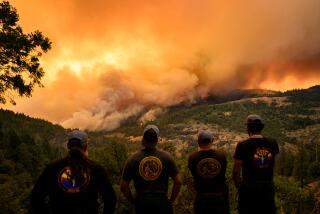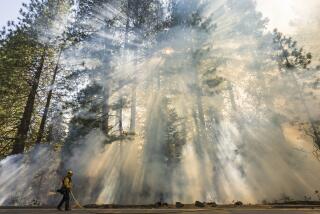Yosemite fire has burned 210 square miles; among state’s worst
GROVELAND, Calif. — The Rim fire continued to grow overnight, burning 133,000 acres in and around Yosemite National Park, officials said Sunday.
The blaze — the 15th largest in California history — has burned 210 square miles and is now 7% contained, according to Cal Fire.
Officials said they continued to deal with dry conditions and winds that have helped the fire spread so quickly.
Here is how the fire looks from space:
NASA satellite sees Rim Fire from space: [photo] https://t.co/pAXo57ttbM— NASA Goddard Images (@NASA_GoddardPix) August 25, 2013
Getting to the fire has proven difficult for firefighters.
“Direct attack is being used in some areas of the fire and more will be utilized as firefighters gain safe access,” according to Inciweb, a fire Web service. “In other areas of the fire where extremely steep, rugged and inaccessible terrain exists, fire crews are using a tactic called indirect attack, which creates control lines away from the fire’s active edge.”
The fast-moving blaze marched powerfully through pristine wilderness all of last week, doubling in size since Thursday, forcing evacuations, shutting down the main highway to the famed national park and damaging the Hetch Hetchy reservoir’s water and power system.
More than 2,600 firefighters battled the blaze Saturday. Although they were assisted by trench-digging bulldozers and water-dropping aircraft, their efforts had little effect. The Rim fire, which began eight days ago in a remote canyon of the Stanislaus National Forest, was just 5% contained.
“This fire is burning unlike anything we’ve seen in this area historically,” said Ashley Taylor, a U.S. Forest Service spokeswoman.
More than 1,800 firefighters were sent to Tuolumne City at the northwestern edge of the fire to protect the community’s 1,600 homes. “Our priority is Tuolumne right now. It’s in the line of fire,” said another fire official.
Aside from the hot, dry weather and the rugged and hard-to-reach terrain, another difficulty was the blaze’s tendency to burn the tops of trees, creating a “crown fire” with long, intense flames that skip across forested land faster than a wildfire that creeps along near the ground.
The blaze continued to threaten small communities throughout the area, some of which had been abandoned by residents, tourists and business owners who fled after looking skyward and seeing gray plumes of smoke or columns of flame rising from nearby mountain ranges. Tuolumne City and Ponderosa Hills, home to about 2,000 people, were under voluntary evacuation orders. Parts of Groveland were evacuated Friday.
The fire burned to the back door of Pine Mountain Lake, a gated community in Groveland. But firefighters held the fire line for three days. On Saturday evening, joyous residents began returning home.
With little hope that the fire could be quickly wrestled into submission, crews focused their efforts on guiding the blaze away from buildings and campgrounds. “If you can’t stop a fire, you try to divert it,” said Johnny Miller, a Cal Fire spokesman.
The fire has so far destroyed nine structures and threatened about 5,500 others. One firefighter suffered heat exhaustion but no other injuries were reported.
The San Francisco Public Utilities Commission has been forced to shut down two of its three hydroelectric power stations near the Hetch Hetchy reservoir, and Gov. Jerry Brown on Friday extended a state of emergency to include San Francisco because the reservoir is a major source of electricity and water for the city.
RELATED: Gov. Brown declares state of emergency
Firefighters were able to contain part of the fire near the reservoir and power plants Saturday, giving utility crews access to the stations to assess the damage, said Michael Carlin, a deputy general manager with the commission. The commission has purchased power on the open market and has seen only a slight dip in production as a result of the fire, Carlin said.
The blaze also closed Highway 120, a primary thoroughfare into the park. Fire crews dotted the two-lane roadway Saturday. Some stopped to monitor the blaze as it raced through nearby mountain passes. Others worked on containment lines near the road as fire and smoke rose in the distance.
“We are watching in front of us and we are watching in back of us,” said Adam Harkey, a member of the Rio Bravo “hotshot” crew. Harkey and his team carefully observed a column of orange and black smoke that seemed to be rising about a mile away. They hoped to figure out which direction the closest flames were heading. A few moments later, fearing the fire was headed their way, Harkey and his team began moving to the trees near the roadway, pulling out chain saws and shovels, cutting trees and digging to create a containment line.
Larry Brown, who was volunteering for the Tuolumne County Sheriff’s Department, said the Rim fire was “coming in at a close second” to a rash of wildfires that scorched hundreds of thousands of acres around the state in 1987. Four firefighters died battling those blazes, including one who was crushed by a falling tree in the Stanislaus National Forest. Tuolumne County was among the hardest-hit areas.
Because the fire is confined to the park’s more remote northwestern section, campers in the Yosemite Valley have been largely unaffected, park ranger and spokesman Scott Gediman said.
“It’s 20 miles from the Yosemite Valley,” Gediman said. “It’s still beautiful skies and very little smoke impact to Yosemite Valley and the park.”
ALSO:
Residents fight ‘mega-yachts’ in Newport Beach
Yosemite fire one of the largest in California history
Hundreds gather at Leimert Park to remember March on Washington
More to Read
Sign up for Essential California
The most important California stories and recommendations in your inbox every morning.
You may occasionally receive promotional content from the Los Angeles Times.












